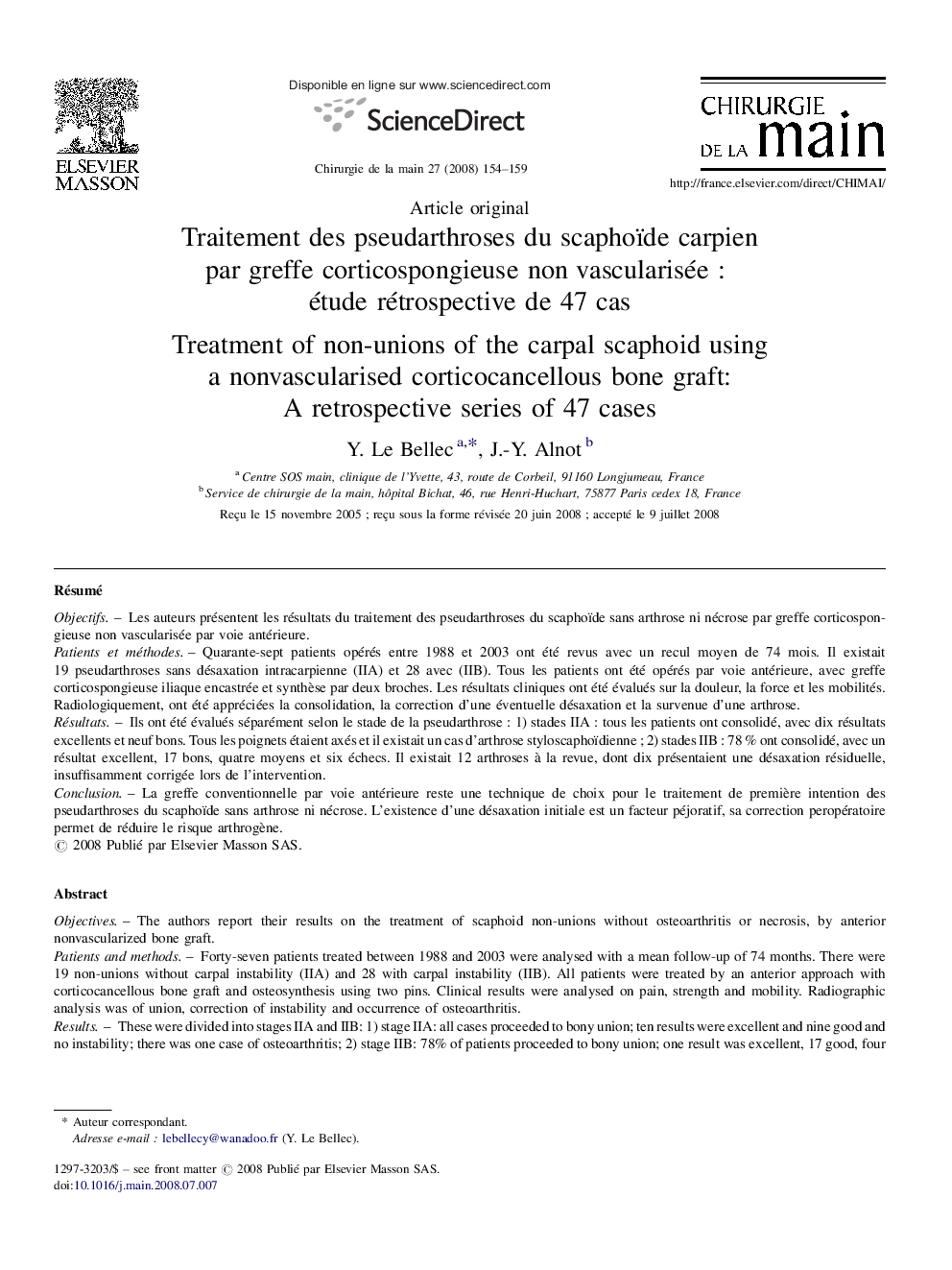| Article ID | Journal | Published Year | Pages | File Type |
|---|---|---|---|---|
| 4049858 | Chirurgie de la Main | 2008 | 6 Pages |
RésuméObjectifsLes auteurs présentent les résultats du traitement des pseudarthroses du scaphoïde sans arthrose ni nécrose par greffe corticospongieuse non vascularisée par voie antérieure.Patients et méthodesQuarante-sept patients opérés entre 1988 et 2003 ont été revus avec un recul moyen de 74 mois. Il existait 19 pseudarthroses sans désaxation intracarpienne (IIA) et 28 avec (IIB). Tous les patients ont été opérés par voie antérieure, avec greffe corticospongieuse iliaque encastrée et synthèse par deux broches. Les résultats cliniques ont été évalués sur la douleur, la force et les mobilités. Radiologiquement, ont été appréciées la consolidation, la correction d’une éventuelle désaxation et la survenue d’une arthrose.RésultatsIls ont été évalués séparément selon le stade de la pseudarthrose : 1) stades IIA : tous les patients ont consolidé, avec dix résultats excellents et neuf bons. Tous les poignets étaient axés et il existait un cas d’arthrose styloscaphoïdienne ; 2) stades IIB : 78 % ont consolidé, avec un résultat excellent, 17 bons, quatre moyens et six échecs. Il existait 12 arthroses à la revue, dont dix présentaient une désaxation résiduelle, insuffisamment corrigée lors de l’intervention.ConclusionLa greffe conventionnelle par voie antérieure reste une technique de choix pour le traitement de première intention des pseudarthroses du scaphoïde sans arthrose ni nécrose. L’existence d’une désaxation initiale est un facteur péjoratif, sa correction peropératoire permet de réduire le risque arthrogène.
ObjectivesThe authors report their results on the treatment of scaphoid non-unions without osteoarthritis or necrosis, by anterior nonvascularized bone graft.Patients and methodsForty-seven patients treated between 1988 and 2003 were analysed with a mean follow-up of 74 months. There were 19 non-unions without carpal instability (IIA) and 28 with carpal instability (IIB). All patients were treated by an anterior approach with corticocancellous bone graft and osteosynthesis using two pins. Clinical results were analysed on pain, strength and mobility. Radiographic analysis was of union, correction of instability and occurrence of osteoarthritis.ResultsThese were divided into stages IIA and IIB: 1) stage IIA: all cases proceeded to bony union; ten results were excellent and nine good and no instability; there was one case of osteoarthritis; 2) stage IIB: 78% of patients proceeded to bony union; one result was excellent, 17 good, four moderate and six cases remained un-united. There were 12 cases of osteoarthritis. Most of them occurred in patients with residual instability after the initial surgical procedure.ConclusionCorticocancellous nonvascularized bone graft by a palmar approach is an excelllent technique for treatment of scaphoid non-unions without osteoarthritis and necrosis. The presence of instability is a poor prognostic factor; its correction during the operation allows the surgeon to decrease the risk of osteoarthritis.
